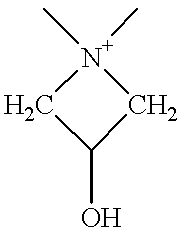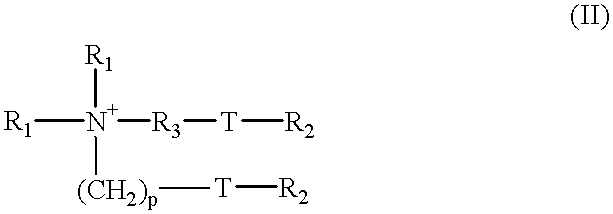Fabric care composition
a technology of fabric care and composition, applied in the field of fabric care composition, can solve the problems of fabric surface appearance, fabric can be damaged in several ways, and the laundry process is too harsh to treat fabri
- Summary
- Abstract
- Description
- Claims
- Application Information
AI Technical Summary
Benefits of technology
Problems solved by technology
Method used
Image
Examples
examples 1 to 6
[0078] Ten identical washloads were prepared and labelled, each consisting of:
[0079] Ten 40 cm squares of washed off cotton sheeting crease monitors, overlooked and ironed
[0080] Ten 40 cm squares of washed off cotton interlock crease monitors, overlooked and ironed
[0081] Ten 40 cm squares of washed off viscose crease monitors, overlooked and ironed
[0082] Ten 40 cm squares of washed off 65 / 35 polyester cotton crease monitors, overlooked and ironed
[0083] Cotton sheeting ballast to make the load up to 2.7 kg
[0084] The ten loads were labelled and treated with increasing levels of PAE in combination with a commercially available rinse conditioner containing a quaternary ammonium compound
[0085] This rinse conditioner comprises about 20 to 25% quaternary ammonium fabric softening and / or conditioning compound(s) and a perfume.
[0086] The loads were subjected to five washes in Whirlpool.TM. automatic washing machines, having two washes in one machine, and three washes in the second machine. P...
example 7
[0094] Examples 1 to 6 were repeated using the cationic polymer obtainable by the reaction of epichlorohydrin with an amino-terminated poly(oxyalkylene) prepolymer, Polymer AM.TM. (from Precision Process Textile, Ambergate, UK). Again, a crease reduction was observed after five washes at the low levels of 0.0075% and 0.010% owf.
example 8
[0095] The softness experiment carried out in Examples 1 to 6 was repeated on a washload of terry towelling. Analysis was by paired comparison between samples treated with the commercially available concentrated rinse conditioner described in Examples 1 to 6 alone and those treated with the same rinse conditioner with added PAE.
[0096] For rinse conditioner containing 0.0075% owf PAE, 46 out of 48 comparisons chose fabric treated with this composition as more soft.
[0097] By way of comparison, for rinse conditioner containing 0.03% owf PAE, 35 out of 36 comparisons chose fabric treated with this composition as more soft.
PUM
| Property | Measurement | Unit |
|---|---|---|
| Fraction | aaaaa | aaaaa |
| Fraction | aaaaa | aaaaa |
| Fraction | aaaaa | aaaaa |
Abstract
Description
Claims
Application Information
 Login to View More
Login to View More - R&D
- Intellectual Property
- Life Sciences
- Materials
- Tech Scout
- Unparalleled Data Quality
- Higher Quality Content
- 60% Fewer Hallucinations
Browse by: Latest US Patents, China's latest patents, Technical Efficacy Thesaurus, Application Domain, Technology Topic, Popular Technical Reports.
© 2025 PatSnap. All rights reserved.Legal|Privacy policy|Modern Slavery Act Transparency Statement|Sitemap|About US| Contact US: help@patsnap.com



